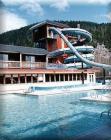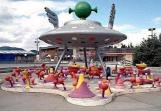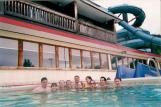1
Orleans began his tenure at the hot springs with a sense of grandioseness, much like Skoglund had, decades before: he intended to create what the Terrace Review referred to as a 'playground for the elite,' complete with a golf course, a therapeutic clinic, and a helicopter on standby to take guests heli-skiing. Orleans planned to build a resort hotel centres around the main hot springs pool, which would be enclosed in a dome of glass and surrounded by a tropical garden. 'You'll be able to go from the dead of winter to the tropics just by walking in the door,' he told the Terrace and District Chamber of Commerce in 1987.2
Mt. Layton Hot Springs Resort PostcardLakelse Lake, British Columbia, Canada
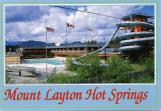 Credits:
Credits:Photo Credit: Mel Basaraba
Caption on verso reads: 'Facilities will appeal to all ages, with a mini turtle slide for tots, waterslides for the daring and warm therapeutic mineral water for "aches and older". This water playground of all ages is located just 15 min. S
3
During the interim period (1979-1985) when the Lakelse hot springs property was owned by the provincial government, local residents and governments consistently expressed concern that any development of the Lakelse hot springs should take the local audience into account. During the 1979 election, federal candidates for the Skeena region campaigned on promises to do something about the dormant hot springs. Following the election, MLA Frank Howard and MP Jim Fulton formally requested that a committee of local people be formed to inspect the hot springs premises.In 1981, Howard again pushed the issue of combining regional 'forces' to ensure development of the hot springs would 'serve local needs and desires.' 'In my view when Ray Skoglund developed the Springs he did it the correct way,' Fulton proclaimed. 'He built the facility there to accommodate people from the region and gave it a local-oriented and family flavoured atmosphere. I feel very strongly that the concept which now exists at the provincial level is one oriented towards a large-scale development which could easily see local residents disadvantaged.' Politicians were worried that people in Terrace, Kitimat, and the surrounding areas would not be welcome at their own recreation site.
Echoing Fulton's sentiments the next year, Employment Agency Manager Juanita Hatton organised a Lakelse Hotsprings Development Association and called for interested residents and groups to attend a discussion. 'If government goes ahead on its own,' Hatton warned, 'the work will be done without any real concern for the people of the area.'
Restoring the Lakelse hot springs to their former local glory arose as an issue again during the 1983 election debates. When Minister Anthony Brummet called for unconditional tenders to sell the hot springs property in late 1984, communities were scared, fearing that resort development could leave them behind. There had been only tepid interest in developing the property up to that point, and the provincial government refused to attach the conditions that local groups wanted. Developers would have to meet local standards of governance, and would also have to 'structure the development in such a way to ensure the support and patronage of the local residents.' This, Brummet implied, would occur strategically rather than through restrictions during the point of sale.
Throughout their dormant period, residents across the northwest asserted a constant concern that the hot springs should be developed as a regional rather than as a national resource. The anxiety has recurred with every phase of the hot springs development, belying an uncertainty about the northwest's role within the nation, an insularism common to small, rural communities, and a measure of distrust of development.
4
Mt. Layton Hot Springs Resort Hot Tub, Swimming Pool, and Waterslides.2000s
Lakelse Lake, British Columbia, Canada
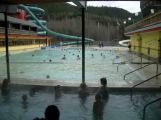
5
The UFO H20 was purchased by Bert Orleans following the disposition of Vancouver's Expo '86 displays. The UFO H20 boasted innovative technology in 1986: a new process was used to remove air and impurities from water, allowing designers to make water dance out of extraterrestrial accoutrements in new and strange ways. Many of the 22 million visitors to Expo '86 would have played in or marvelled at the innovative waterpark. Its presence at Mt. Layton Hot Springs gave the northern resort a cosmopolitan air, connecting it to world events. Some time in the 1990s, the intricate pipes became clogged with mineral deposits from the hot springs water. The waterpark has sat, dry and dormant, ever since.6
The grand opening of Mt. Layton Hot Springs Resort was celebrated on 27 February 1988. The completion of the first phase-which included pools, waterslides, and a café-was lauded by dignitaries including Lloyd Johnstone, MLA Dave Parker, Minister Dave Parker, Minister Bill Reid, and Kitimat Mayor Ray Brady. The second phase of development included an 18-hole golf course, a 100 to 300 room high-end hotel, an indoor-outdoor swimming pool, an island getaway, a gas station and grocery store, ball fields, rodeo grounds, and a therapeutic clinic.7
Granddaughters of Ray Skoglund and Lloyd Johnstone at the Opening of Mt. Layton Hot Springs Resort.2 March 1988
Lakelse Lake, British Columbia, Canada
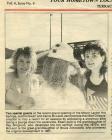 Credits:
Credits:Ray Skoglund's granddaughter Justine Ewart and Lloyd Johnstone's granddaughter Carrie McLeod at the grand opening of Mt. Layton Hot Springs Resort.
Excerpted from the front page of the 2 March 1988 edition of The Terrace Review.
9
Kitimat's Bert Orleans purchased the hot springs property from the provincial government in 1985. Orleans, of Kitimat, owned and operated a tugboat company out of Kitimat and Prince Rupert. The Lakelse hot springs had by then been closed to the public for seven years, and there was much anxiety about reopening the resource to the region. Orleans was the highest bidder of five interested parties. Assistant Deputy Minister of Timber and Land Marketing Tom Lee noted that Bert Orleans 'was the person we selected as being the most qualified and committed to carry out the project.'10
Rainbow Above the Waterslides at Mt. Layton Hot Springs Resort.1990s
Lakelse Lake, British Columbia, Canada
 Credits:
Credits:Photographer: Lance Armstrong.
11
Happy at the Entrance to Mt. Layton Hot Springs Resort.Summer 1992
Lakelse Lake, British Columbia, Canada
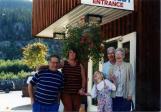 Credits:
Credits:Left to right: Mike and Fran Skitcko, Jennifer Christison, Eric Christison, and Aleza Christison.
12
In the first phase of development, Bert Orleans built a warm swimming pool with diving area, a large hot tub, three waterslides, two children's waterslides and a children's swimming pool, complete with a UFO-style children's waterpark from Expo '86. The pools were treated with an ozone water treatment system imported from Germany. The restaurant was cutting-edge for the 1980s, and the cafeteria windows provided a view of the hot tub and pool. The Johnstone Dining Room featured fine dining, and the Rooftop Gardens were available for conferences or private bookings. The licensed Splashdown Lounge had a view of the pools and water slides: from the comfort of a table beside the large stone fireplace, you could watch children splash into the indoor pool at the bottom of the two main water slides, or laugh as braver souls picked themselves up out of the exterior Cannonball trough.13
Pool and Waterslides at Mt. Layton Hot Springs Resort.1990s
Lakelse Lake, British Columbia, Canada
